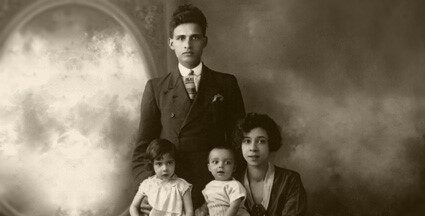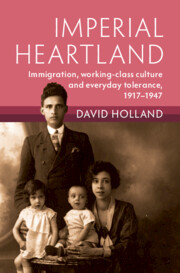
Reproduced by kind permission of Glenda Munro, all rights reserved.
In 1919 and 1920, a number of British ports suffered large-scale race riots as mobs targeted non-white men of various ethnicities. On the receiving end of these apparently spontaneous outbursts of racially motivated violence were mostly seafarers from colonised territories in the British Empire, whose numbers had markedly increased during the First World War. The riots were, it has been argued, sparked by two key factors: competition for seafaring jobs during the post-war economic slump and the fraternisation of white women with non-white men. In the contemporary press, inter-racial mixing was said to have enraged those who found their conception of a stable and hierarchical racial order deeply challenged by so-called ‘miscegenation’.1
The port riots loom large in our recent understanding of how working-class Britons perceived ‘racial’ difference. Combined with the rise of Oswald Mosley’s Blackshirts during the 1930s, they have come to characterise a febrile and racialised atmosphere during the first half of Britain’s twentieth century. It was certainly believed by many of those in authority at the time that even the presence of even small numbers of non-white men in Britain had the potential to spark racially motivated disorder. Measures such as the extension to the Aliens Act, 1919 – the Coloured Alien Seamen Order (CASO) – were introduced to exclude non-whites from working-class communities, especially in the ports. As a consequence, our view of British domestic ‘race-relations’ during the interwar period has been primarily informed by these destructive events and the reactions to them. 2
Our understanding is reinforced by the lurid press headlines, sermonising editorial comments and eugenic activism of the period, all of which decried ‘miscegenation’ and ‘racial degeneration’. Nevertheless, despite the hostility of state officials, the eugenic movement, elements within the working classes and much of the press, robust social bonds formed between white working-class natives and South Asians through marriage, friendship and work. These social networks, mostly non-political in nature, demonstrate that other processes were in play in the period preceding mass New Commonwealth immigration in the 1950s and 1960s. They are, my new book argues, of crucial significance if we wish to understand the spectrum of social and cultural responses of native – especially working-class – Britons to the early and pioneering immigration of the colonised peoples of Britain’s empire.
Like the ports, Sheffield, a large inland northern English city globally famed for its steel and metalworking industries, also experienced the arrival of numerous non-white, male, immigrant workers – mostly former seafarers of Muslim South Asian origin – during the First World War and throughout the interwar period. Despite a very brief and localised episode of racially motivated violence one evening in February 1921, the reactions of working-class natives to these young South Asian men overturn many of our pre-conceptions that hostility to perceived racial difference was an overriding pre-occupation of working-class people during this period. The social networks of South Asian immigrants, moreover, comprised both natives and newcomers and clearly negated the imperial imperative of keeping the ‘races’ separate. Based on intermarriage and co-habitation with, mostly white, natives as well as cordial and co-operative relationships with workmates, neighbours, in-laws and through trade, they extended across the length and breadth of Britain, across the British Empire and beyond.
In 1957, the anthropologist Sydney Collins, one of the very few black scholars working in British universities at that time, argued that ‘immigrant minorities do not exist in a vacuum’, and that the conventional approach of studying the immigrant population in isolation and ‘more or less excluding the host society’ is an expedient but ‘inadequate approach to the problem’. Despite the recognition of these relationships by a small number of anthropologists and historians over the years, their significance has long been neglected as a subject for historical study. With Collins’s admonition in mind, my new book, based on a host of new and neglected sources, seeks to address this issue. 3
Today, much of what we know of early South Asian and other non-white immigration and settlement in Britain is thanks to scholars who have studied the mass of documentary evidence left by those arms of the British State concerned with the ‘problem’ of colonised people who were not of the educated classes. These studies have provided many previously unrecognised insights into the machinations of the British state, the ‘official mind’ and the outlooks and motivations of individuals and state bureaucracies, when related to issues of race and power. This is especially true of official attempts to deny colonised people’s formal rights as British subjects to live and work in Britain. A notable feature of this scholarship is its extensive and sustained challenge to previous self-congratulatory narratives of innate British tolerance and fair play.
Despite such laudable aims and achievements, the problem inherent in this approach to immigration history is that a focus on hostile sources generally only reveals immigrant individuals and populations identified by various state officials. For example, sources related to those South Asian immigrants not of the educated and professional classes depict them as itinerant opportunists attracted by the relatively easy life provided by the welfare system of the day. Indeed, according to one senior Home Office civil servant they were ‘impecunious’ or ‘illiterate’ Indians ‘of the agricultural class’. South Asian immigrants thus appear to us as deracinated interlopers, adrift and unwelcome within the imperial heartland, with little or no connection to native Britons and often the objects of hostility and resistance to their presence.
My book differs in its approach by paying greater attention to those documentary sources which reveal immigrants’ connections to society and culture within the British imperial heartland. Changing the lens to one focussed on instances of co-habitation, co-operation and inter-marriage with native, mostly white, Britons reveals a startlingly different picture of acceptance and rootedness within working-class neighbourhoods. These relationships were, it may be argued, hiding in plain sight within the General Register Office’s comprehensive records of births, deaths and marriages and within electoral rolls. Once located, however, the fine grain of everyday life is brought to light by the incorporation of recently released census data, press reports and through oral histories. In this way, previously hidden immigrant populations, such as that of the Sheffield area, are revealed.
To illustrate this point, my own study developed after being alerted to a somewhat forgotten and neglected grave in Sheffield. The headstone is inscribed ‘In loving memory of Souriya, beloved daughter of Ayaht and Hilda Khan, died July 30th, 1929 aged 9 months (Mohammedan religion)’. In a city where the South Asian population is generally viewed as having begun to arrive only in the 1950s, Souriya, a child born to an ethnically mixed marriage at that time, might today be viewed as a somewhat anachronistic curiosity. We might also imagine that these individuals and couples were outliers to the great mass of society; that they were treated as outcasts and pariahs in communities too imbued with ideas of empire and white racial and civilisational supremacy to accept their presence. Nevertheless, further investigation, discovered that Souriya and her family were not isolated from wider society. She was born into circumstances where she was an accepted and loved member of a social network which transcended boundaries of ‘race’, culture and faith.
Consequently, I found that analyses based on largely hostile documentary sources somewhat unsatisfactory in the sense that they did not sufficiently answer questions of how these relationships formed and sustained themselves if the social climate was so unrelentingly hostile. In response, my book attempts to address this issue and goes some way to answering the question of what, if not unrelenting hostility, was the actuality of native–newcomer relations in the first half of the twentieth century. In doing so it pays close attention to instances of constructive interaction between (mostly white) natives and South Asian newcomers, who rubbed along together quite tolerably, despite their observable cultural, confessional or ‘racial’ differences. The book examines this ‘everyday tolerance’ in detail to reveal a picture of British society that has been overlooked for generations.
Recent histories of the long-neglected experiences of early South Asian settlers and sojourners in Britain rightly acknowledge the hostility they sometimes faced. Nevertheless, broad-brush analyses, which treat British society as monolithic, that suggest only a binary relationship between ‘aggressors’ and ‘victims’ or of all-encompassing theories of ‘structures of power’ or social class, are blunt instruments not well suited to examining the diversity of human experience in the past. This is especially true when examining the personal agency of individuals who possessed their own agendas in life and whose experiences lay within the relatively unexamined working-class milieu.
Rather than viewing immigration through the lens of inevitable conflict, the book situates mixed marriages and inter-ethnic social networks centrally within the South Asian settlement of modern Britain. In doing so it demonstrates that there is abundant evidence for the existence of positive relations and robust social bonds between natives and newcomers. Rather than attempting to whitewash historical examples of racism, the book contextualises them within a much larger picture of successful immigration, settlement and integration, which steadily grew throughout the period, often aided by white working-class natives. It challenges assumptions that insurmountable barriers of race, religion and culture existed between working-class people and non-white newcomers, therefore offering a fresh perspective on the social and cultural history of modern Britain.

Latest Comments
Have your say!